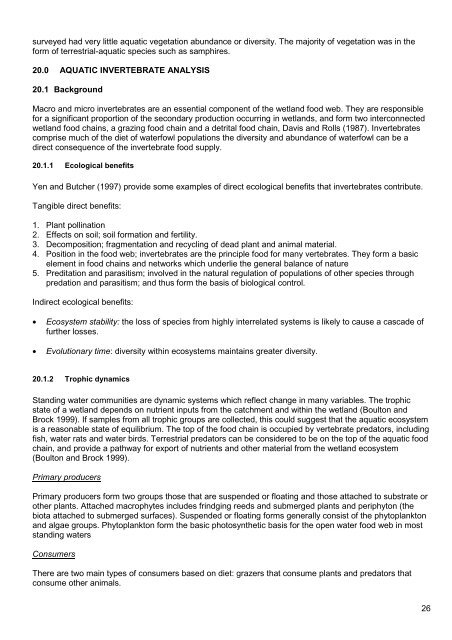2007 Wetland Inventory for the Eyre Peninsula
2007 Wetland Inventory for the Eyre Peninsula
2007 Wetland Inventory for the Eyre Peninsula
- No tags were found...
You also want an ePaper? Increase the reach of your titles
YUMPU automatically turns print PDFs into web optimized ePapers that Google loves.
surveyed had very little aquatic vegetation abundance or diversity. The majority of vegetation was in <strong>the</strong><strong>for</strong>m of terrestrial-aquatic species such as samphires.20.0 AQUATIC INVERTEBRATE ANALYSIS20.1 BackgroundMacro and micro invertebrates are an essential component of <strong>the</strong> wetland food web. They are responsible<strong>for</strong> a significant proportion of <strong>the</strong> secondary production occurring in wetlands, and <strong>for</strong>m two interconnectedwetland food chains, a grazing food chain and a detrital food chain, Davis and Rolls (1987). Invertebratescomprise much of <strong>the</strong> diet of waterfowl populations <strong>the</strong> diversity and abundance of waterfowl can be adirect consequence of <strong>the</strong> invertebrate food supply.20.1.1 Ecological benefitsYen and Butcher (1997) provide some examples of direct ecological benefits that invertebrates contribute.Tangible direct benefits:1. Plant pollination2. Effects on soil; soil <strong>for</strong>mation and fertility.3. Decomposition; fragmentation and recycling of dead plant and animal material.4. Position in <strong>the</strong> food web; invertebrates are <strong>the</strong> principle food <strong>for</strong> many vertebrates. They <strong>for</strong>m a basicelement in food chains and networks which underlie <strong>the</strong> general balance of nature5. Preditation and parasitism; involved in <strong>the</strong> natural regulation of populations of o<strong>the</strong>r species throughpredation and parasitism; and thus <strong>for</strong>m <strong>the</strong> basis of biological control.Indirect ecological benefits:• Ecosystem stability: <strong>the</strong> loss of species from highly interrelated systems is likely to cause a cascade offur<strong>the</strong>r losses.• Evolutionary time: diversity within ecosystems maintains greater diversity.20.1.2 Trophic dynamicsStanding water communities are dynamic systems which reflect change in many variables. The trophicstate of a wetland depends on nutrient inputs from <strong>the</strong> catchment and within <strong>the</strong> wetland (Boulton andBrock 1999). If samples from all trophic groups are collected, this could suggest that <strong>the</strong> aquatic ecosystemis a reasonable state of equilibrium. The top of <strong>the</strong> food chain is occupied by vertebrate predators, includingfish, water rats and water birds. Terrestrial predators can be considered to be on <strong>the</strong> top of <strong>the</strong> aquatic foodchain, and provide a pathway <strong>for</strong> export of nutrients and o<strong>the</strong>r material from <strong>the</strong> wetland ecosystem(Boulton and Brock 1999).Primary producersPrimary producers <strong>for</strong>m two groups those that are suspended or floating and those attached to substrate oro<strong>the</strong>r plants. Attached macrophytes includes frindging reeds and submerged plants and periphyton (<strong>the</strong>biota attached to submerged surfaces). Suspended or floating <strong>for</strong>ms generally consist of <strong>the</strong> phytoplanktonand algae groups. Phytoplankton <strong>for</strong>m <strong>the</strong> basic photosyn<strong>the</strong>tic basis <strong>for</strong> <strong>the</strong> open water food web in moststanding watersConsumersThere are two main types of consumers based on diet: grazers that consume plants and predators thatconsume o<strong>the</strong>r animals.26
















